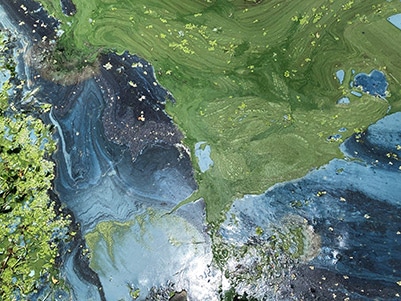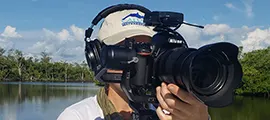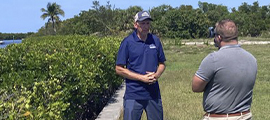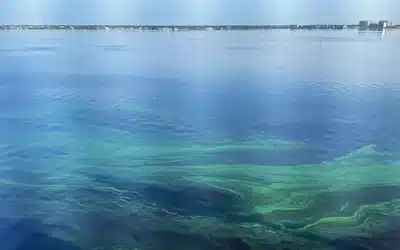Issue:
Harmful Algal Blooms

Blue-green Algae (Cyanobacteria)
Cyanobacteria is one of the oldest types of lifeforms on Earth and is found primarily in freshwater systems. There are thousands of species of cyanobacteria and many are known to produce a variety of toxins.
Cyanobacteria is a photosynthetic microorganism that processes sunlight, nitrogen and phosphorous to live. They can regualate their position in the water column for optimal light and thrive in warm, nutrient-rich fresh or brackish water with low turbulence.
Microcystis and Anabaena are two of the most common cyanobacteria found in estuarine systems today. These bacteria are known to produce cyanotoxins dangerous to humans and animals. Microcystin and Anatoxin are classes of hepatoxin and neurotoxin, affecting the liver and brain, respectively.
Human and animal exposure to Cyantoxins comes in three primary forms of contact:
- Dermal contact
- Inhalation or aspiration from aerosolized surface water
- Ingestion
Harmful algal blooms have severe impacts on human health, aquatic ecosystems and our economy.
Red Tide (Karenia brevis)
Red tide is a marine dinoflagellate found in saltwater, and has been known to inhabit the Gulf of Mexico throughout recorded history. Red tide blooms have been increasing in scope and intensity within the last 30 years. Red tide has also occurred throughout the Gulf and Atlantic Coast, reaching as far as North Carolina.
Karenia brevis can utilize at least 12 different forms of nutrients and also consume other single cell organisms for food. They are capable of motion and directed swimming allowing them greater access to nutrients.
Red Tide produces brevatoxins which can be deadly to many sea animals and often causes acute respiratory symptoms in humans. Aerosolized health effects include irritation of the eyes, nose, throat and lungs and exacerbating occurrences of respiratory distress, bronchitis, asthma and pneumonia. Brevatoxin can also have a serious impact on the marine food-chain, contributing to shellfish poisoning and gastrointestinal disorders.

Take Action
Contact Your State Legislators
Calusa Waterkeeper calls on citizens and stakeholders to urge elected officials and responsible agencies to take the following ten actions:
The toxic blue-green algae (cyanobacteria) often stretching from Lake Okeechobee to our west coast is the result of decades of failed water policy implementation. A perfect storm of lax enforcement and under-funding at the local, state and national levels has culminated in the historic harmful algae blooms (HABs) that plagued our region in 2018 (and so many other years).
If political leaders fail to take action, history is doomed to repeat itself year after year, causing catastrophic harm to our ecosystem and our economy.
The science is clear on what needs to be done.
What has been lacking is the political will to enact the regulation and legislation required to begin to reverse these problems. We look to you, as informed citizens, to proactively communicate your water quality concerns to newly elected officials. It will take a groundswell of voices if we are to affect change in Tallahassee during this coming legislative session.
Find Your Legislators
Related News Stories
Harmful Algal Blooms
Summer is here and so is the blue-green algae
The temperature is heating up in the air, and the water. We know that blue-green algae is something we deal with in the summer, but Calusa Waterkeeper volunteers tell me it’s early in the season for canals to look like this…
Calusa Waterkeeper Petitions EPA for Cyanotoxin Standards in Florida
Calusa Waterkeeper is among five conservation organizations and the City of Stuart, Florida to petition the Environmental Protection Agency to set limits on the dangerous algae bloom toxins that now routinely threaten the health of Floridians and wildlife.
Blue-Green Algae Toxins are a Human Health Risk
A recent News-Press article (“Well-known FGCU professor accused of downplaying blue-green algae by water advocate”) overlooks the principal barrier to public understanding of Florida’s persistent blue-green algae – the calibration of exposure to risk.
Shades of Blue Water Turning Green
So far this summer, Army Corps officials have been releasing Lake Okeechobee water in pulses as the lake level rises and the wet season continues, which is leading to blue waters of the Caloosahatchee Estuary and connected waterways to turn green with algal blooms.
Testing Relationship Between Algae Outbreaks and Health Concerns
Water infested with blue-green algae is not safe to swim in, play in or drink because of harmful toxins. Although, far less is known about what’s in the air regarding those same algae outbreaks. Calusa Waterkeeper & volunteers deploy ADAM, aka Aerosol Detector for Algae Monitoring, to monitor & sample air near algae outbreak hotspots.
New Tech Studying Blue-Green Algae in SWFL
Calusa Waterkeeper continues to deploy their high-tech ADAM devices around our local watershed for studying the blue-green algae outbreaks. Blooms are present on the lake, in the Caloosahatchee and along canals in Southwest Florida.
Make a Donation
Get Notified
Priority Issues
Harmful Algal Blooms
Cyanobacteria & Red Tide
Cyanobacteria (blue-green algae) and Karenia brevis (red tide) have been making major impacts on Southwest Florida.
Lake Okeechobee Discharges
Revise System Operating Manual
The Caloosahatchee River often suffers from too much freshwater in the wet season, and not enough freshwater in the dry season.
Cape Coral Spreader Canals
Nutrient & Sediment Loading
The City of Cape Coral is working to remove large storm-water barriers to make recreational boating more convenient.
Bacteria Monitoring
Fecal Indicator Bacteria
Calusa Waterkeeper has been at the forefront of monitoring this Fort Myers tributary for fecal bacteria indicators.




































